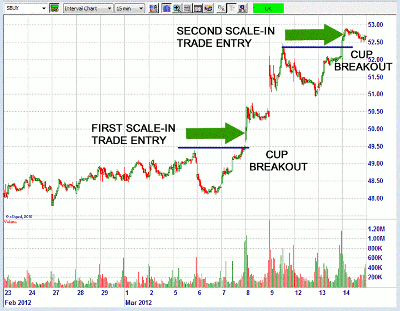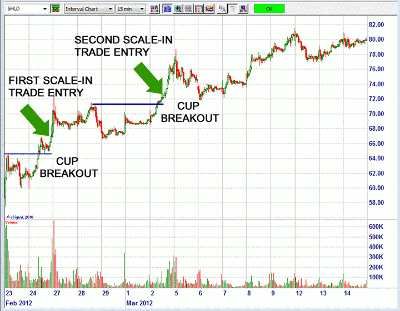Whether swing or daytrading stocks or exchange traded funds, Ken Calhoun tells why it’s smart to “scale into” trades by starting with small size, then adding to those that are successful.
Professional traders seldom do “all-or-nothing” trades, in which an entire position is entered at once. Amateur retail traders make the error of entering large positions with single trading decisions, which can cause costly stops, and missed opportunities. Unsuccessful traders often make the cardinal error of adding to losing positions, which can be disastrous for trading accounts.
Let’s look at how experienced traders manage their trades, using a series of incremental trades that build into winning positions while minimizing the costs of stop-losses.
Keep Out of Trouble: Start off with Small “Pilot” Trades
The first rule when trading is to minimize the cost of errors with small stop losses. The best way to accomplish this is by starting off trades with small size (for example, entering trades with an initial share size of just 20-50 shares, instead of 100-1000 shares or more), and diversifying by entering more trades with smaller size, rather than just a few trades with large size.
Managing risk by starting off with a handful of these small-size “pilot” trades also builds trader confidence, because there’s not as much worry about the cost of being wrong. If, for example, a 20-share trade goes against the trader by one point, that’s a $20 (plus commission) stop loss, which is smart, compared to starting with a 200-share trade, which, if it goes against the trader by one point, would cost $200 (plus commissions).
So, for example, instead of allocating capital to just eight or ten larger-sized positions, it’s often more effective to instead trade 20-25 smaller-sized positions across various strong sectors to capitalize on strong moves.
Whether swing or daytrading stocks or exchange traded funds (ETFs), it’s smart to “scale in” to trades by starting with small size, then adding to those that are successful.
How to Scale Into Winning Trades
Although it limits initial profit potential, small-share entries also limit stop-loss costs, which is critical (especially for new traders).
Consider Figure 1, [Starbucks (SBUX)] for a stock swing-trade example. A series of trade entries are made above each new “cup” breakout (a cup looks like the letter U and indicates buying strength above the cup’s high). In the case of SBUX, that would be at $49.70 and again over $52.50 with a stop loss set at the breakeven point (which, in this case, would be around $51.20).
The goal is to add to that small percentage of winning trades incrementally. One guideline is to set a specific dollar figure by which a trade has to be “in the money” before adding to it (such as “It has to be in the green by at least $120 before adding to an open swing trade”).
By focusing your efforts on that small handful of winning trades and adding to them sequentially following continuation breakouts, it’s possible to “build" a position over time that is very successful.
NEXT: How to Exit Winning Open Trades
|pagebreak|How to Exit Winning Open Trades
If the chart drops from here, the hard stop gets the trader out at breakeven, as is the goal. If it continues up, then another trade could be entered following another cup breakout, and so on.
Typically, trades may move for up to two to four “scale-in” trades before pulling back, which is ample time to scale into a winning trade before a reversal occurs.
In practice, a trader may find that many trades either cause small initial stops, or get “breakeven trades” because after a second position is entered, a reversal will pull the price back to even. It’s the ones that do continue up that account for the biggest gains in a traders’ account. This may be just a small percentage of overall trade entries (10%-30%), but that’s fine.
By combining careful, strategic trade-management tactics with entry pattern recognition skills, traders can plan how to exit trades in a way that leads to one of three potential outcomes: 1) a small stop; 2) a breakeven “scratch” trade; or 3) a moderate win after scaling into a second and possibly third or even fourth trade that’s continuing in the trend.
Also, by initiating new trades on small size, that also mitigates the risk associated with gaps against the trade since the initial share size is small. Exiting at the first sign of trouble (for example, under a two-day low for open long swing trades), is instrumental in protecting open profits.
Another example can be found in Figure 2 [Sears Holdings, (SHLD)], in which sequential cup breakouts clearly indicated how to “scale in” to a position over the $66.00 level and again over $72.00 for adding to winning open long trade positions.
Professional Trading Insights: Trade Management Tips
By starting everything off small and skeptically considering it a “test” trade on new-high breakouts (for longs), a trader can adopt a more professional approach. Keeping risk as small as possible while building winning trades over time with a series of several entries (compared to a single all-or-nothing trade) is a much smarter, conservative way to trade the markets.
Tip #1: Set a fixed amount of capital to initiate each trade; i.e. no more than 1% of your total capital account (for example, $300 for a $30,000 account). While it may test your patience to trade small, it’s also a particularly effective “bounce back” technique to rebuild a portfolio that’s suffered serious drawdowns (in addition to being a solid approach for successful veteran traders as well).
Tip #2: Use two-day lows (loss of prior day + current day’s low) as the absolute stop loss for stock and ETF swing trades, and no more than .08 to .40 for intraday trades. Most professional daytrading stops are .04 -.12 or so in size, just to keep things tight.
Tip #3: When adding to winning trades, build a "reverse martingale," in which trade one is one unit, trade two is one unit, trade three is two units, trade four is four units, and so on. For example, trade one is ten shares, trade two adds another ten shares to an open winner, trade three adds 20 shares to the first shares, and trade four adds 40 shares to the now-40-share position that’s been built (and should by now have an open profit of at least $150-$400 for a swing trade, for example). This makes all trades start small and “prove themselves” before the trader adds to their position.
Tip #4: Diversify widely and based on strongest sectors. If, for example, the retail sector is strong, I’ll be trading stocks like Sears Holdings(SHLD), Target (TGT), Wal-Mart (WMT), and Costco (COST), and may have open small-share “pilot” trades in all four stocks. Or, if stocks in the retail coffee sector are strong, I may trade both Starbucks and Green Mountain Coffee Roasters (GMCR).
It’s important to build a mini-portfolio of actively traded stocks so that you are trading multiple instruments in strong sectors. This also builds confidence because you’re not emotionally invested to any single position, but instead are “playing the field” to see which ones take a lead that can then be added to.
Using careful risk management by scaling in to “build" winning positions while having plenty of small stops and breakeven-type trades along the way is a more professional, strategic approach to active trading.
Traders wipe out their accounts by adding to losing positions, overtrading choppy charts, trading too few stocks and ETFs on too-large initial share size, and letting losing positions continue against them. By using a more diversified, careful approach when trading, it’s possible to limit losses significantly while taking moderate, scaled-in gains from Wall Street.
By Ken Calhoun of Daytrading University
Ken Calhoun is a trading professional who has traded millions of dollars of equities since the 1990s and is the producer of multiple award-winning trading courses and video-based training systems for active traders. He is a UCLA alumnus and is the founder of DaytradingUniversity.com, a popular online educational site for active traders.












